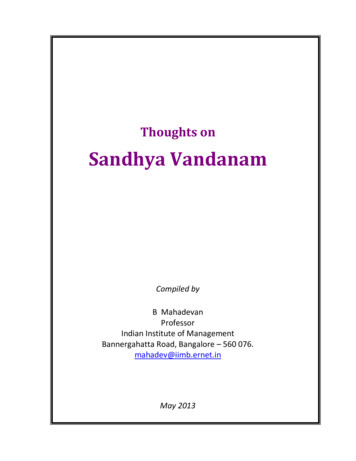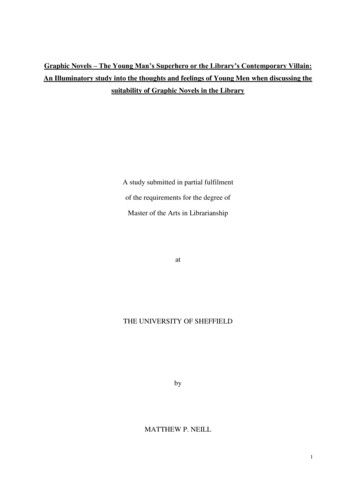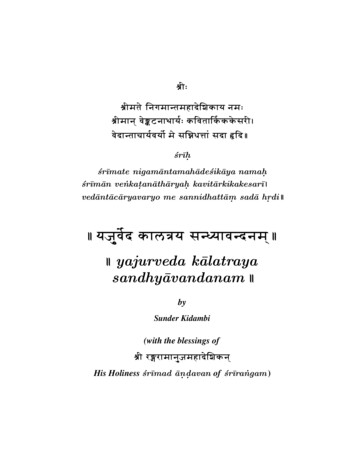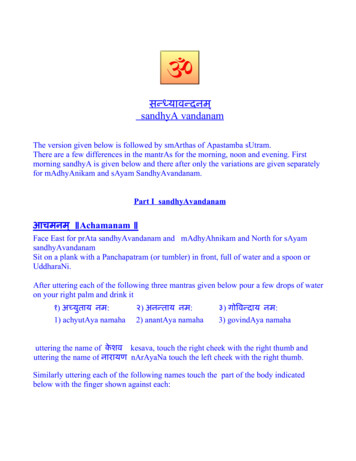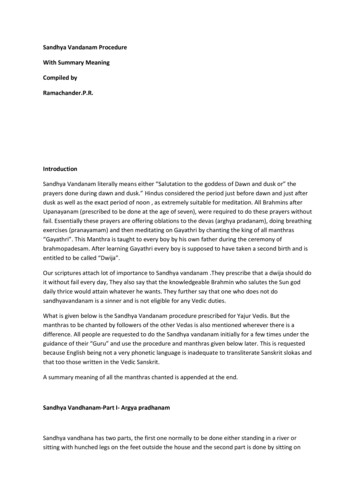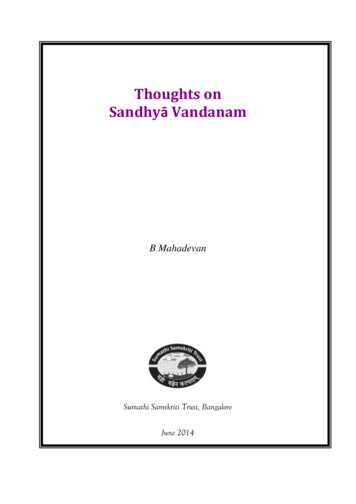
Transcription
Thoughts onSandhyā VandanamB MahadevanSumathi Samskriti Trust, BangaloreJune 2014
Contents1.2.3.4.5.6.7.8.PrefaceImportance of Sun WorshipUpanayanamSandhyā Vandanam as a Nitya KarmaTimely observance of Sandhyā Vandanam Karma21Overall Structure of Sandhyā Vandanam MantrasSome aspects of Prayoga in Sandhyā VandanamFAQs on Sandhyā VandanamConversation of a Devotee with Sringeri JagadguruShri Chandraśekhara Bhārati Mahā Swamigali191527314151
Guide to Transliteration symbols used in the bookThe transliteration schema used in this book is based on International Alphabetof Sanskrit Transliteration (IAST). IAST is a transliteration scheme that allows alossless romanization of scripts as employed by the Sanskrit language. The detailsare given �्traवvaऽ‘Othersक्षkṣajñaśra
iPrefaceWe are living in an era characterized by scientific discoveries ofvarious kinds. In the last two hundred and fifty years we havediscovered new technologies one after the other. These haveplayed a major role in shaping our thinking and the way of life.However, more importantly, as a nation, we have also beenintroduced to a number of ideas from the western civilizations.One important impact of this is a general feeling among anaverage, well‐meaning educated Indian that anything of westernorigin is good, credible and the way to go forward. Even thetraditionally educated pandits in the country crave forrecognition of their scholarship by the western educated group.With the result there is a widespread feeling that anythingworthwhile must pass through the lens of western acceptance.The recent onslaught of mass media and computers and thesuccess of media convergence as a reliable technology seem toaccelerate this process. As a result there is a heightenedexposure to other social structures and practices across theglobe. Indian society is fast joining the global melting pot ofculture and social practices.Imbibing newer ideas and practices is generally viewed as a signof evolution and growth. However, replacing altogether one setof cultural practices with another does not amount to evolution.At times it can be counter‐productive and retrograde in nature.Therefore, giving up one’s own native culture and socialpractices is not a healthy idea for any society. The Indian societyis preparing to make such a choice. However, there is ambiguityand confusion among the citizens about the pros and cons ofsuch a choice. With the result a vast majority of our populationare like the cat on the wall not knowing what to do.
iiInterestingly, on the other side, there is a growing interestamong the youngsters to know more about the Indian traditions.Current educational policies and practices encourage them to“question” everything. This is in sharp contrast to the AncientIndian paradigm of having a very healthy “spirit of inquiry”.There is a subtle difference between the two approaches, eventhough the basic motivation seems to be one of getting clarifiedabout an unknown concept. A sprit of inquiry stems out ofhumility whereas an attitude of questioning arises out of ego.A natural extension of this attitude has resulted in them wantingto know more about some of the ancestral knowledge andcultural practices that we follow even today. Honestly, a vastmajority of youngsters are simply clueless about various facetsof Ancient Indian wisdom. They are anxiously waiting forsomeone to discuss these in a language and a format that theyare used to.Ancestral Indian wisdom is rich, multi‐faceted and profound. Itoffers grand paradigms for living and setting goals for one’s ownprogress in life. It also has multiple perspectives on some of theimportant issues such as attaining peace, tranquility andcontentment. These are organized systematically in severallayers. Sṛti, which is otherwise known as Vedas and Upaniṣadshas defined governing principles for life. On the other hand,Smṛtis have detailed them and provided useful guidelines by wayof rules for day‐to‐day living. The Dharma śāstras provide thesedetails and specify Sāmānya and Viśeṣa dharmas. They also pointto Nitya and Naimittika karmas that everyone must follow.Sandhyā Vandanam is the basic and most fundamental Nityakarma to be followed by Brahmins, Kshatriyas and Vaiśyasbelonging to all the four āshramas. However, unfortunately inthe current context of jet setting and hectic life styles many have
iiiabandoned this important duty. Many others are performinghalf‐heartedly, not knowing what they are doing and why. Thereare still many more who have been diligently following thepractice of performing Sandhyā Vandanam three times daily.This booklet has been prepared keeping a target group ofyoungsters and office goers in mind. This group has always beenhaving a question about the usefulness of this karma, itsimportance and its primacy in our scheme of daily living. SinceEnglish has become the defacto medium for all and the sundry,this has been written in English. The choice of the language andthe style of writing are such that the target audience will be ableto read it with ease and relate the ideas without much difficulty.However, it does not mean we need to compromise on theoriginal intent and messages that our ancestors have withrespect to Gāyatrī mantra and Sandhyā Vandanam. Therefore,while compiling various ideas I have quoted generously fromearlier writings, Dharma śastra and other texts that I have beenable to go through to the extent possible.I do not claim expertise in the subject matter. I have been greatlybenefitted by reading three commentaries on SandhyāVandanam. The first is a two part essay in Kannada by HisHoliness Jagadguru Sri Abhinava Vidyā Tīrtha Mahā Swamigal ofsṛngeri śāradā Peeṭham. One essay was on Gāyatrī Mahimā andthe other on Sandhyā Mahimā. These essays were subsequentlytranslated into Tamil by Changanur Subramaniya Aiyar Trust,Coimbatore and published in 1999 by Śri Śaradā Trust,Bangalore.The second source is a bhashya on Sandhyā Vandanam bySrivatsa Somadeva Sarma, the founder of Vaidika DharmaVardhini, Chennai. This bhāṣya was published in Tamil in 1952.
ivThe third source was the Sandhyā Vandanam Bhāṣya by “Anna”and published by Ramakrishna Math, Mylapore, Chennai in1956. I was also greatly benefited by the book “SamkṣepaDharma Sāstra” written in Tamil by Manjakudi VenkatramaSastrigal and published by Heritage India Educational Trust,Mylapore, Chennai in 1985.I have added some modern features in this write up including anFAQ (Frequently Asked Questions) section. I have also taken theliberty to reproduce an interesting conversation between anEducational Officer and His Holiness Jagadguru SriChandraśekhara Bhārati Swāmigal of Sringeri Śārada Peeṭham.This is indeed an inspiring conversation. It adds like a crownjewel to this write up.The desire to bring some of the interested youngsters back intothe fold of Sanātana Dharma motivated me to venture into thisexercise. If there are any errors and omissions it is entirely dueto my ignorance of the subject matter. I beg to be forgiven andrequest the readers to be kind enough to bring it to my attentionso that I can correct them.B MahadevanJune 2014
1Importance of Sun worshipEveryone is aware that the presiding deity of worship throughSandhyā Vandanam is the Sun God. As per the practice, SandhyāVandanam is expected to be done daily thrice without fail untilwe breath our last. Therefore, the first question that comes toour mind is what is the idea behind this? Why did our ancestorsaccord so much importance to Sun worship? It is important toreflect on the need for this, the significance of sun worship andthe role of the Sun God in worldly matters.If we carefully go through the ancient Indian literature, we willfind that prayer to the Sun occupies most prominence, SandhyāVandanam being one, albeit important element. The celebratedAruna Praśnaḥ (also known as Sūrya Namaskāram), which is apart of the Taittirīya Aranyaka of Krishna Yajur Veda is a hymnto the Sun God, is recited with fervor even today. Even in day‐to‐day Yoga practices, Sūrya Namaskāram is an integral aspect. Allthese point to the centrality of the Sun in many worldly matters.Sun – The very reason for our existenceWhy is the Sun so important that we need to pray to the Sun Godthree times a day? Let us look at modern science first. Anybodywho has some familiarity with basic physics knows that thesustainability of the earth critically depends on the Sun, which isthe centre of the solar system associated with the earth.Balanced climatic conditions, regularity of rainfall, availability ofwater and natural resources to not only the mankind but also to
P a g e 2the entire living creatures and the plant kingdom are possibleonly because of the Sun. If for some reason the Sun chooses tocome closer to the earth by an inch we will all be burnt to ashesand the entire solar system will lose its equilibrium. Similarly, ifthe Sun decides not to rise on the earth’s horizon for a week, itwill lead to catastrophic effect on the entire living system in theplanet earth.To quote Swami Ranganathananda’s commentary on the Gītā1, “ All our energy comes from the Sun. We have in India, idealizedthe concept of the Sun. In fact, The National GeographicMagazine of USA (Sep. 1948) in its article on “The SmithsonianInstitution” by Thomas R Henry says: “The sun is the greatMother. All life on earth may be considered as transientmaterialization of the exhaustless floods of radiance which shepours on the planet’s surface. This enables green plants tosynthesize sugars and starches from water in the soil and fromcarbon‐di‐oxide gas in the atmosphere, thus making possible allother essential foods. We eat sun in sugar, bread, and meat, burnsunshine millions of years ago in coal and oil, wear sunshine inwool and cotton; sunshine makes the winds and the rain, thesummers and winters of years and ages. Particularly interwovenare the threads of life and light. ”In Praśna Upanishad, in response to a query, from KātyāyanaKabandhī one of the six disciples, “Wherefrom the creatures areborn?”, Sage Pippalāda replies that it comes out of matter (Rayi)and energy (Prāṇa). The sage further explains that the Sun isverily the life and the Moon is the matter. 212Swami Ranganathananda (2000), “The Universal Message of the BhagavdGītā: Volume 1”, pp 356 – 357.See Praśna Upaniṣad (1.3 to 1.5) for more details on this.
P a g e 3अथ कबन्धी कात्यायन उपेत्य प च्छ । भगव कुते ह वा इमाः जाःजायन्त इित ॥atha kabandhī kātyāyana upetya papraccha, bhagavan kute ha vāimāḥ prajāḥ prajāyanta iti.रिंय च ाणं चेत्येतौ मे बहु धा जाः किर यत इित ॥आिदत्यो ह वै ाणो रियरे व चन्दर्मा .rayim ca prāṇam cetyetau me bahudhā prajāḥ karṣhyata iti.ādityo ha vai prāṇo rayireva chandramā A great source of inspirationLet us turn our attention to another aspect of the Sun. It isknown to us by common sense that light is the source ofenthusiasm, inspiration and energy for the life to go on. Also,bright light and the very notion of brightness in various formsare associated with knowledge, power and strength. The wordTejas in Sanskrit nearly captures all these aspects and relates itto the Sun. For all these reasons, light is associated with anythingthat is Divine. That is why in India the practice is to have acircular bright light source behind idols in temples (and even inphotographs depicting divine entities and Gods).If we reflect on the source of light to the earth, it is only the Sun.Without the Sun there is no possibility of finding an alternativesource of light. All other known sources of light such as theMoon, current electricity from any available source are nothingbut derived sources of the Sun. Therefore, it is only natural tocontemplate on this ultimate source of prosperity to themankind. Recognizing such a central role of the Sun in our day‐
P a g e 4to‐day matters, our ancestors have felt it fitting to reflect on theSun as the ultimate source of inspiration and knowledge. Thebear minimum expected out of us, as a matter of modern daysimple courteous living, is to say thank you Oh! Sun for all thatyou are doing to keep us alive.According to Swami Rāma Tīrtha, the great Mathematicianturned Sannyāsi who lived in the beginning of 20th century, “TheSun in the material world is a symbol of light, that is to sayknowledge, The Sun is a symbol of power, it makes all theplanets revolve. It is a symbol of existence, life: all life owes itsorigin to or is indebted to the Sun. The Sun is a symbol of beauty;it attracts the earth and everything – so dazzling. Now the Sunrepresents knowledge, light, life, power, existence, beauty andattractiveness ”.3The Notion of TimeIn the modern parlance some of the most commonly heardphrases are “I am too busy, I have not time ”. We need toobjectively think for a moment to understand what is thereference frame for us to make such comments. The notion oftime, the notion of day and night are all nothing butmanifestations of the Sun. Bhartṛhari in has Vairāgya śatakabrings this idea very beautifully as follows:आिदत्य य गतागतैरहरहः संक्षीयते जीिवतंयापारै � कालोऽिप न ायते ।ādityasya gatāgataiḥ aharahaḥ samkṣīyate jīvitamvyāpāraiḥ bahu‐kārya‐gurubhiḥ kālopi na jñāyate3In woods of God‐Realization, Vol. 2, pp. 70, Swami Rama Tirtha Pratisthan,2007.
P a g e 5As the Sun raises and sets every day, one’s life shortens and (theflight of) time is not felt because we are too busy with a numberof activities. The most important point to note is that withoutthe Sun, we may not be able to measure time, know how muchtime has passed and set deadlines for many of our personal andprofessional activities that we pursue.This is well articulated in the fourth mantra in Aruṇa Praśna. TheSun exercises certain Lordship over the Earth by being beyondthe Earth and casting its lig
Contents Preface i 1. Importance of Sun Worship 1 2. Upanayanam 9 3. Sandhyā Vandanam as a Nitya Karma 15 4. Timely observance of Sandhyā Vandanam Karma 21 5. Overall Structure of Sandhyā Vandanam Mantras 27 6.
